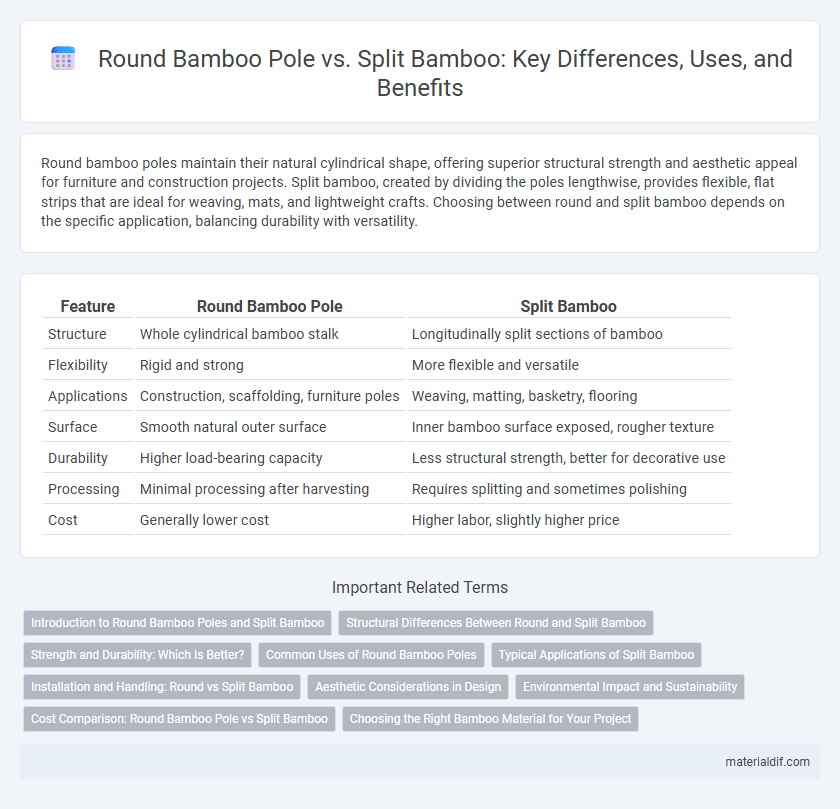Round bamboo poles maintain their natural cylindrical shape, offering superior structural strength and aesthetic appeal for furniture and construction projects. Split bamboo, created by dividing the poles lengthwise, provides flexible, flat strips that are ideal for weaving, mats, and lightweight crafts. Choosing between round and split bamboo depends on the specific application, balancing durability with versatility.
Table of Comparison
| Feature | Round Bamboo Pole | Split Bamboo |
|---|---|---|
| Structure | Whole cylindrical bamboo stalk | Longitudinally split sections of bamboo |
| Flexibility | Rigid and strong | More flexible and versatile |
| Applications | Construction, scaffolding, furniture poles | Weaving, matting, basketry, flooring |
| Surface | Smooth natural outer surface | Inner bamboo surface exposed, rougher texture |
| Durability | Higher load-bearing capacity | Less structural strength, better for decorative use |
| Processing | Minimal processing after harvesting | Requires splitting and sometimes polishing |
| Cost | Generally lower cost | Higher labor, slightly higher price |
Introduction to Round Bamboo Poles and Split Bamboo
Round bamboo poles are cylindrical, maintaining the natural shape of the bamboo stalk, making them ideal for structural applications like scaffolding, furniture, and construction due to their strength and flexibility. Split bamboo involves cutting the bamboo stalk lengthwise into flat strips, enhancing versatility for weaving, paneling, and lightweight furniture, with a smoother surface ideal for aesthetic finishes. Both forms leverage bamboo's renewable qualities, but round poles emphasize durability while split bamboo prioritizes adaptability and design.
Structural Differences Between Round and Split Bamboo
Round bamboo poles retain the natural cylindrical shape of the bamboo, providing high tensile strength and flexibility for structural applications like scaffolding and framing. Split bamboo involves cutting the round pole lengthwise into narrow strips, which increases surface area and allows for woven or flat panel construction but reduces bending resistance. The choice between round and split bamboo depends on load-bearing requirements, with round poles preferred for primary structural support and split bamboo suited for decorative or lightweight structural elements.
Strength and Durability: Which Is Better?
Round bamboo poles possess superior strength due to their intact cylindrical structure, providing high load-bearing capacity and resistance to bending. Split bamboo, although more flexible and easier to work with, loses some structural integrity during the processing, reducing its overall durability compared to round poles. For applications requiring long-term strength and stability, round bamboo poles are the preferred choice.
Common Uses of Round Bamboo Poles
Round bamboo poles are commonly used in construction for scaffolding, fencing, and framework due to their natural strength and flexibility. They are also popular in furniture making and garden trellises, providing structural support while maintaining an aesthetic appeal. Unlike split bamboo, round poles retain their cylindrical shape, making them ideal for load-bearing applications and decorative purposes.
Typical Applications of Split Bamboo
Split bamboo is predominantly used in construction for lightweight scaffolding, wall paneling, and fencing due to its flexibility and ease of handling. Its slender segments make it ideal for weaving mats, baskets, and furniture, enhancing durability while maintaining a natural aesthetic. Split bamboo also finds applications in crafting musical instruments and decorative elements, leveraging its smooth texture and uniform shape.
Installation and Handling: Round vs Split Bamboo
Round bamboo poles offer greater ease in handling and faster installation due to their uniform shape and natural strength, making them ideal for structural use. Split bamboo, while more flexible and lightweight, requires careful alignment and additional securing techniques during installation to maintain stability. Choosing between round and split bamboo depends on the specific project demands for durability and speed of assembly.
Aesthetic Considerations in Design
Round bamboo poles exhibit a sleek, natural curvature that enhances minimalist and organic design aesthetics, creating flowing lines and a warm texture. Split bamboo offers a flat, smooth surface ideal for paneling or weaving, providing versatile geometric patterns and refined finishes in both modern and traditional interiors. Designers often choose round bamboo for its sculptural appeal, while split bamboo is favored for structured, textural applications that emphasize craftsmanship.
Environmental Impact and Sustainability
Round bamboo poles require less processing energy and produce minimal waste compared to split bamboo, making them a more environmentally friendly option. Split bamboo involves additional labor and machinery to transform poles into thin strips, increasing carbon emissions and resource consumption. The sustainability of round bamboo poles is enhanced by their durability and natural strength, reducing the need for chemical treatments and frequent replacements.
Cost Comparison: Round Bamboo Pole vs Split Bamboo
Round bamboo poles generally cost more than split bamboo due to their structural integrity and less processing required after harvesting. Split bamboo involves additional labor for cutting and shaping, increasing production expenses but offering versatility for construction and weaving projects. Choosing between round and split bamboo depends on budget constraints and the intended application, with round poles favored for strength and splits preferred for detailed craftsmanship.
Choosing the Right Bamboo Material for Your Project
Round bamboo poles offer natural strength and flexibility, making them ideal for structural applications such as scaffolding, fencing, or furniture frames. Split bamboo provides a flat, flexible surface suited for weaving, paneling, and decorative crafts, enhancing aesthetic appeal and versatility. Selecting between round and split bamboo depends on project requirements, including load-bearing capacity, design complexity, and intended durability.
Round bamboo pole vs Split bamboo Infographic

 materialdif.com
materialdif.com